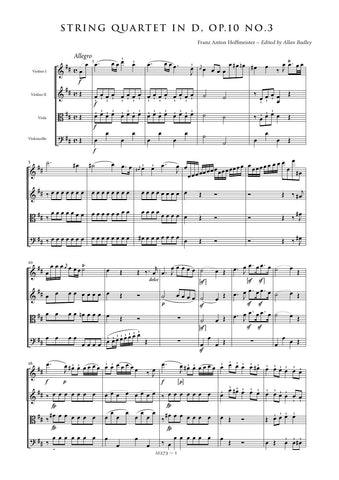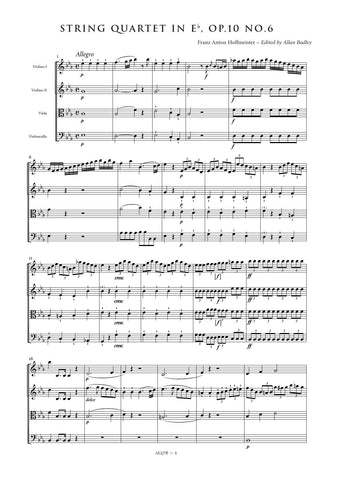Details
|
According to Roger Hickman Hoffmeister composed and published 34 string quartets between 1781 and 1806. The three Op.14 Quartets were advertised in the Wiener Zeitung on 15 January, 1791 as the composer's newest works. They were dedicated to M. Joseph de Preuer Senior, a lawyer resident in Linz. Although modest in scope and emotional depth, all three works reveal Hoffmeister as a craftsman of refined musical sensibilities. They show a clear grasp of the conversational style of the genre, as cultivated especially by his great compatriot and true master of the genre, Joseph Haydn, and reveal a kinship with the Mozartian string quartet style in their translucent scoring, harmonic richness and melodic invention. Hoffmeister's liking for third-related juxtapositions is frequently apparent, as is his awareness of the varied textural opportunities - duets and trio scoring for example – offered by the four voices. Taken together, the freshness and vitality of all three Op.14 Quartets make them extremely worthwhile additions to the repertory of 18th-century Viennese string quartets.
The D minor Quartet is the most substantial of the three works, partially as a result of the choice of the minor key, but also owing to the use of a four-movement structure in contrast to the three-movement schemes adopted in the other two works. All three quartets begin with an opening sonata form movement; the D minor Quartet continues with a slow movement set of variations in the dominant key, with a central minore episode. Hoffmeister retains the tonic major established with the first movement recapitulation for the following Menuetto but returns to the tonic minor for the trio section. Most striking of all however are the harmonic similarities between the first bars of the finale and the opening of the Minuet movement from Mozart's String Quartet in D K.499 which Hoffmeister had himself published in 1786. It is impossible to determine whether this was a conscious tribute to his slightly younger colleague and friend, but in any case it provides a fascinating musical link between Mozart and an all but forgotten contemporary.
The present edition reproduces as faithfully as possibly the text of the Op.14 Quartets as transmitted in Hoffmeister's own first edition of the works, a copy of which is preserved in the Austrian National Library in Vienna, Shelfmark MS 41670. Of interest in the D minor Quartet is the appearance of some fingering in the first violin part (see bars 63-64 of the first movement) which appears to derive from the composer himself. This has been included in the edition in italic type. The style and notation of articulation and dynamic markings have been standardized throughout, and, where missing from the print, markings have been reconstructed from parallel passages.These are indicated by the use of dotted slurs or brackets where appropriate.
Hoffmeister's notation of appoggiature is somewhat inconsistent. The first violin part part uses flagged quavers throughout whilst the second violin part uses plain unflagged quavers. The present edition has standardized these to unflagged quavers mainly to prevent their interpretation as acciaccature in the instances where appoggiature are surely intended. Hoffmeister's symbol for the turn is also inconsistent, so again this has been standardized. Obvious wrong notes have been corrected without comment, and editorial emendations with no authority from the print are placed within brackets.
Dianne James
|















